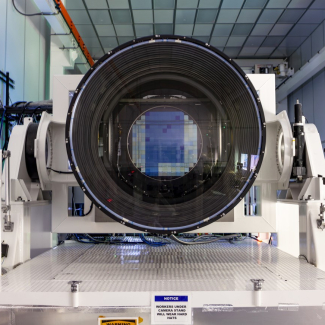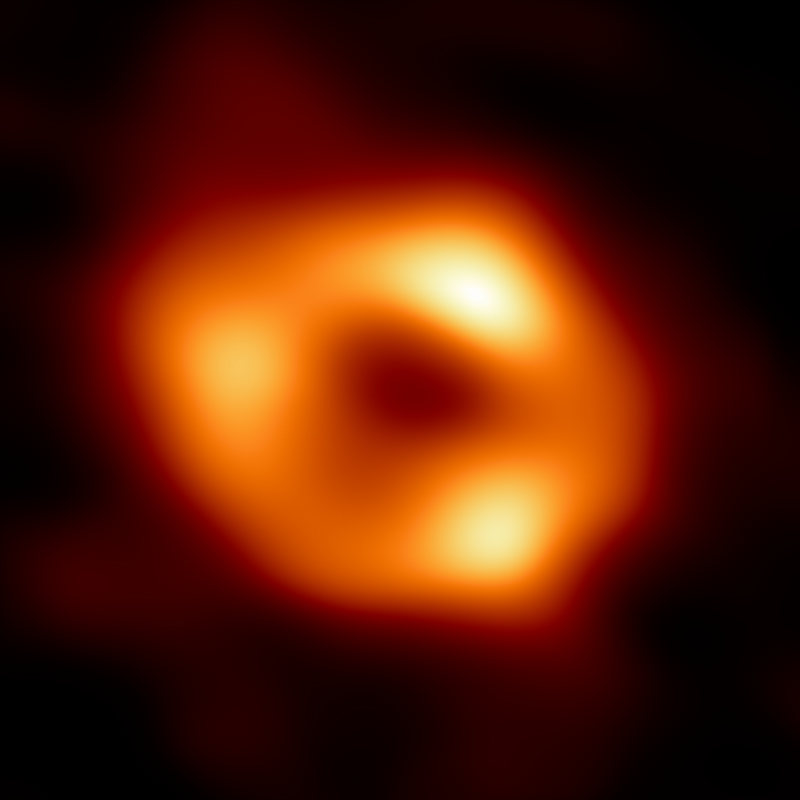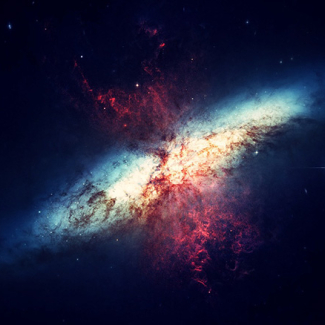
Astronomers reveal first image of the black hole at the heart of our galaxy
|
Astronomers have unveiled the first image of the supermassive black hole at the centre of our own Milky Way galaxy. This result provides overwhelming evidence that the object is indeed a black hole and yields valuable clues about the workings of such giants, which are thought to reside at the centre of most galaxies. The image was produced by a global research team called the Event Horizon Telescope (EHT) Collaboration, using observations from a worldwide network of radio telescopes. The Institute for Millimeter Radio Astronomy (IRAM), founded in 1979 by the CNRS and the Max-Planck-Gesellschaft (MPG, Germany)1 , played a key role in this result via its 30-meter telescope, located near Granada, the most sensitive single antenna of the EHT network. The results are published in The Astrophysical Journal Letters.
The image is a long-anticipated look at the massive object that sits at the very centre of our galaxy. Scientists had previously seen stars orbiting around something invisible, compact, and very massive at the centre of the Milky Way. This strongly suggested that this object — known as Sagittarius A* (Sgr A*, pronounced "sadge-ay-star") — is a black hole, and today’s image provides the first direct visual evidence of it.
Although we cannot see the black hole itself, because it is completely dark, glowing gas around it reveals a telltale signature: a dark central region (called a “shadow”) surrounded by a bright ring-like structure. The new view captures light bent by the powerful gravity of the black hole, which is four million times more massive than our Sun.
“We were stunned by how well the size of the ring agreed with predictions from Einstein’s Theory of General Relativity," said EHT Project Scientist Geoffrey Bower from the Institute of Astronomy and Astrophysics, Academia Sinica, Taipei. "These unprecedented observations have greatly improved our understanding of what happens at the very centre of our galaxy, and offer new insights on how these giant black holes interact with their surroundings.” The EHT team's results are being published today in a special issue of The Astrophysical Journal Letters.
Because the black hole is about 27,000 light-years away from Earth, it appears to us to have about the same size in the sky as a donut on the Moon. To image it, the team created the powerful EHT, which linked together eight existing radio observatories across the planet to form a single “Earth-sized” virtual telescope2 . The EHT observed Sgr A* on multiple nights, collecting data for many hours in a row, similar to using a long exposure time on a camera.
The IRAM 30-meter telescope is the world's most sensitive single-dish telescope in the high-frequency range the EHT uses for observations. Together with the South Pole Telescope, it provided the longest baseline, and, hence, the sharpest images, contributing this way decisively to the high spatial resolution of the Sgr A* images.
The breakthrough follows the EHT collaboration’s 2019 release of the first image of a black hole, called M87*, at the centre of the more distant Messier 87 galaxy.
The two black holes look remarkably similar, even though our galaxy’s black hole is more than a thousand times smaller and less massive than M87*3 . "We have two completely different types of galaxies and two very different black hole masses, but close to the edge of these black holes they look amazingly similar,” says Sera Markoff, Co-Chair of the EHT Science Council and a professor of theoretical astrophysics at the University of Amsterdam, the Netherlands. "This tells us that General Relativity governs these objects up close, and any differences we see further away must be due to differences in the material that surrounds the black holes.”
This achievement was considerably more difficult than for M87*, even though Sgr A* is much closer to us. EHT scientist Chi-kwan (‘CK’) Chan, from Steward Observatory and Department of Astronomy and the Data Science Institute of the University of Arizona, US, explains: “The gas in the vicinity of the black holes moves at the same speed — nearly as fast as light — around both Sgr A* and M87*. But where gas takes days to weeks to orbit the larger M87*, in the much smaller Sgr A* it completes an orbit in mere minutes. This means the brightness and pattern of the gas around Sgr A* was changing rapidly as the EHT Collaboration was observing it — a bit like trying to take a clear picture of a puppy quickly chasing its tail.”
The researchers had to develop sophisticated new tools that accounted for the gas movement around Sgr A*. While M87* was an easier, steadier target, with nearly all images looking the same, that was not the case for Sgr A*. The image of the Sgr A* black hole is an average of the different images the team extracted, finally revealing the giant lurking at the centre of our galaxy for the first time.
The effort was made possible through the ingenuity of more than 300 researchers from 80 institutes around the world that together make up the EHT Collaboration. In addition to developing complex tools to overcome the challenges of imaging Sgr A*, the team worked rigorously for five years, using supercomputers to combine and analyse their data, all while compiling an unprecedented library of simulated black holes to compare with the observations.
Scientists are particularly excited to finally have images of two black holes of very different sizes, which offers the opportunity to understand how they compare and contrast. They have also begun to use the new data to test theories and models of how gas behaves around supermassive black holes. This process is not yet fully understood but is thought to play a key role in shaping the formation and evolution of galaxies.
“Now we can study the differences between these two supermassive black holes to gain valuable new clues about how this important process works,” said EHT scientist Keiichi Asada from the Institute of Astronomy and Astrophysics, Academia Sinica, Taipei. “We have images for two black holes — one at the large end and one at the small end of supermassive black holes in the Universe — so we can go a lot further in testing how gravity behaves in these extreme environments than ever before.”
Progress on the EHT continues: a major observation campaign in March 2022 included more telescopes than ever before. The ongoing expansion of the EHT network and significant technological upgrades will allow scientists to share even more impressive images as well as movies of black holes in the near future.
By joining the EHT array in 2018 and making its first observations in 2021, IRAM’s second observatory, NOEMA, has already given the EHT a decisive boost in sensitivity, image dynamics, and spatial resolution. However, further development of cutting edge receiver technologies for NOEMA and the IRAM 30-meter telescope will enable the EHT collaboration to gather timelapse images with even finer details. Both facilities will be instrumental for the EHT collaboration towards understanding the physics of massive black holes, and in particular of Sgr A*.
To find out more: https://news.cnrs.fr/articles/black-hole-sgr-a-unmasked

© EHT Collaboration

© IRAM / DiVertiCimes
All articles can be accessed from this page: https://iopscience.iop.org/journal/2041-8205/page/Focus_on_First_Sgr_A_Results
First Sagittarius A* Event Horizon Telescope Results. I. The Shadow of the Supermassive Black Hole in the Center of the Milky Way. The Astrophysical Journal Letters, 12 May 2022. DOI: 10.3847/2041-8213/ac6674
First Sagittarius A* Event Horizon Telescope Results. II. EHT and Multi-wavelength Observations, Data Processing, and Calibration. The Astrophysical Journal Letters, 12 May 2022. DOI: 10.3847/2041-8213/ac6675
First Sgr A∗ Event Horizon Telescope Results. III. Imaging of the Galactic Center Supermassive Black Hole. The Astrophysical Journal Letters, 12 May 2022. DOI: 10.3847/2041-8213/ac6429
First Sagittarius A* Event Horizon Telescope Results. IV. Variability, Morphology, and Black Hole Mass. The Astrophysical Journal Letters, 12 May 2022. DOI: 10.3847/2041-8213/ac6736
First Sagittarius A* Event Horizon Telescope Results. V. Testing Astrophysical Models of the Galactic Center Black Hole. The Astrophysical Journal Letters, 12 May 2022. DOI: 10.3847/2041-8213/ac6672.
First Sagittarius A* Event Horizon Telescope Results VI: Testing the Black Hole Metric. The Astrophysical Journal Letters, 12 May 2022. DOI: 10.3847/2041-8213/ac6756
Contact
Notes
- Joined in 1990 by the Instituto Geográfico Nacional (IGN, Spain)
- The individual telescopes involved in the EHT in April 2017, when the observations were conducted, were: the Atacama Large Millimeter/submillimeter Array (ALMA), the Atacama Pathfinder Experiment (APEX), the IRAM 30-meter Telescope, the James Clerk Maxwell Telescope (JCMT), the Large Millimeter Telescope Alfonso Serrano (LMT), the Submillimeter Array (SMA), the UArizona Submillimeter Telescope (SMT), the South Pole Telescope (SPT). Since then, the EHT has added the Greenland Telescope (GLT), the NOrthern Extended Millimeter Array (NOEMA) and the UArizona 12-meter Telescope on Kitt Peak to its network. ALMA is a partnership of the European Southern Observatory (ESO; Europe, representing its member states), the U.S. National Science Foundation (NSF), and the National Institutes of Natural Sciences (NINS) of Japan, together with the National Research Council (Canada), the Ministry of Science and Technology (MOST; Taiwan), Academia Sinica Institute of Astronomy and Astrophysics (ASIAA; Taiwan), and Korea Astronomy and Space Science Institute (KASI; Republic of Korea), in cooperation with the Republic of Chile. The Joint ALMA Observatory is operated by ESO, the Associated Universities, Inc./National Radio Astronomy Observatory (AUI/NRAO) and the National Astronomical Observatory of Japan (NAOJ). APEX, a collaboration between the Max Planck Institute for Radio Astronomy (Germany), the Onsala Space Observatory (Sweden) and ESO, is operated by ESO. The 30-meter Telescope is operated by IRAM (the IRAM Partner Organizations are MPG (Germany), CNRS (France) and IGN (Spain)). The JCMT is operated by the East Asian Observatory on behalf of the Center for Astronomical Mega-Science of the Chinese Academy of Sciences, NAOJ, ASIAA, KASI, the National Astronomical Research Institute of Thailand, and organizations in the United Kingdom and Canada. The LMT is operated by INAOE and UMass, the SMA is operated by Center for Astrophysics | Harvard & Smithsonian and ASIAA and the UArizona SMT is operated by the University of Arizona. The SPT is operated by the University of Chicago with specialized EHT instrumentation provided by the University of Arizona. The Greenland Telescope (GLT) is operated by ASIAA and the Smithsonian Astrophysical Observatory (SAO). The GLT is part of the ALMA-Taiwan project, and is supported in part by the Academia Sinica (AS) and MOST. NOEMA is operated by IRAM and the UArizona 12-meter telescope at Kitt Peak is operated by the University of Arizona.
- Black holes are the only objects we know of where mass scales with size. A black hole a thousand times smaller than another is also a thousand times less massive.


